AvMap GeoPilot II Plus User Manual
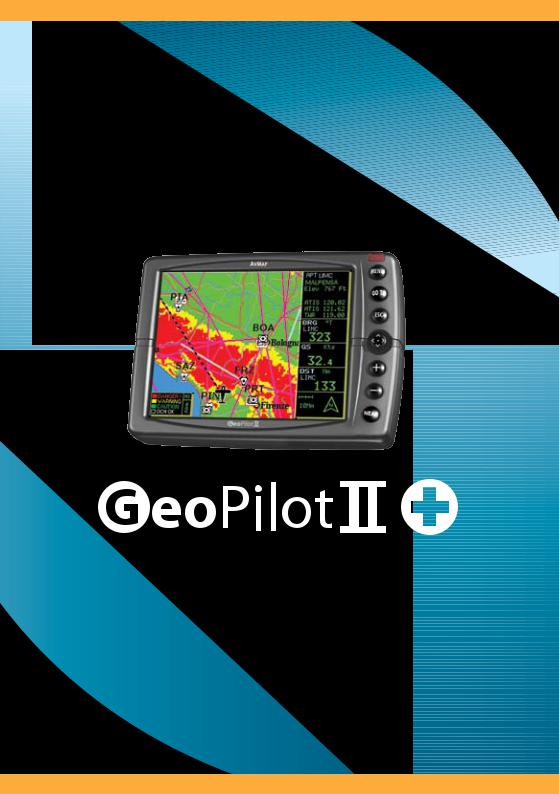
USER MANUAL
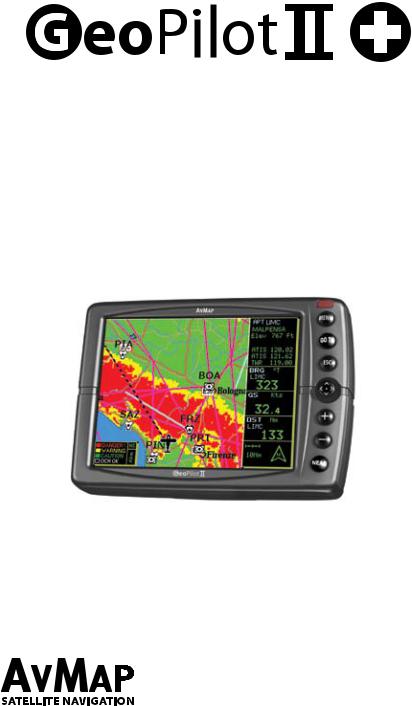
USER MANUAL
Via Caboto, 9
54036 Marina di Carrara - MS - ITALIA E-mail: info@avmap.it

WARRANTY
AvMap warrants their GPS receiver and accessories to be free of defects in material and workmanship for a period of two years from the date of original purchase. This warranty applies only to the original purchaser of this product. In the event of a defect, AvMap, at its option, will repair or replace the product with no charge to the purchaser for parts or labor. The repaired or replaced product will be warranted for ninety (90) days from the date of return shipment, or for the balance of the original warranty, whichever is longer.
PURCHASER’S REMEDY - Purchaser’s Exclusive Remedy under this written warranty or any implied warranty shall be limited to the repair or replacement, at AvMap’s option, of any defective part of the receiver or accessories which are covered by this warranty. Repairs under this warranty shall only be made by an authorized AvMap dealer.
PURCHASER’S DUTIES - To obtain warranty service, the purchaser must return the receiver or accessories post paid, with proof of the date of original purchase and purchaser’s return address to AvMap, or an authorized AvMap representative. AvMap will not be responsible for any losses or damage to the product incurred while the product is in transit or is being shipped for repair. Insurance is recommended.
LIMITATION OF IMPLIED WARRANTIES - Except as set forth above, all other expressed or implied warranties, including those of fitness for any particular purpose and merchantability, are hereby disclaimed. Some states do not allow limitations on warranties, so the above limitation may not apply to you.
EXCLUSIONS - This warranty does not cover the following: Installation, Finishes, Defects resulting from installation. Any damage due to accident, resulting from inaccurate satellite transmissions. Inaccurate transmissions can occur due to changes in the position, health, or geometry of a satellite. Any damage due to shipping, misuse, negligence, tampering or improper use. Servicing performed or attempted by anyone other than an authorized AvMap representative.
 Attenzione! L’esposizione del display ai raggi ultravioletti può accorciare la vita dei cristalli liquidi usati nel vostro plotter cartografico. Questo limite è dovuto alla tecnologia costruttiva degli attuali display. Evitare inoltre che il display si surriscaldi per non causare una diminuzione di contrasto che, in casi estremi, può rendere lo schermo completamente nero. Tale condizione è comunque reversibile durante il raffreddamento.
Attenzione! L’esposizione del display ai raggi ultravioletti può accorciare la vita dei cristalli liquidi usati nel vostro plotter cartografico. Questo limite è dovuto alla tecnologia costruttiva degli attuali display. Evitare inoltre che il display si surriscaldi per non causare una diminuzione di contrasto che, in casi estremi, può rendere lo schermo completamente nero. Tale condizione è comunque reversibile durante il raffreddamento.
 Warning! Exposure of display to UV rays may shorten life of the liquid crystals used in your plotter. This limitation is due to the current technology of the LCD displays. Avoid overheating which may cause loss of contrast and, in extreme cases, a darkening of the screen. Problems which occur from overheating are reversible when temperature decreases.
Warning! Exposure of display to UV rays may shorten life of the liquid crystals used in your plotter. This limitation is due to the current technology of the LCD displays. Avoid overheating which may cause loss of contrast and, in extreme cases, a darkening of the screen. Problems which occur from overheating are reversible when temperature decreases.
 Achtung! Ultraviolette Strahlen können die Lebensdauer vom Flüssigkristalldisplay verkürzen. Die derzeitige LCD-Technologie bedingt diese verkürzte Lebensdauer.
Achtung! Ultraviolette Strahlen können die Lebensdauer vom Flüssigkristalldisplay verkürzen. Die derzeitige LCD-Technologie bedingt diese verkürzte Lebensdauer.
Überhitzung des Displays durch Sonneneinstrahlung führt zu einem Kontrastverlust und in extremen Fällen sogar in eine Schwär zung des Bildschirmes. Bei sinkenden Temperaturen normalisiert sich der Kontrast wieder und die Bildschirminformation wird wieder ablesbar.
 Attention! L’exposition de votre écran LCD aux ultra-violets lors de soleil intense réduira la durée de vie de l’afficheur de votre lecteur. Cette contrainte est liée à la technologie des
Attention! L’exposition de votre écran LCD aux ultra-violets lors de soleil intense réduira la durée de vie de l’afficheur de votre lecteur. Cette contrainte est liée à la technologie des
écrans LCD. Une augmentation trop importante de température peut obscurer des zones de votre écran et le rendre ainsi inutilisable (non couvert par la garantie).
 Aviso! La exposición de la pantalla a los rayos UV puede acortar la vida del cristal líquido usado en su ploter. Esta limitación se debe a la tecnología actual de las pantallas LCD. Evitar que la pantalla se caliente en exceso pues puede causar pérdida de contraste y, en caso extremo, la pantalla puede quedar totalmente negra. Este problema revierte al enfriarse la pantalla
Aviso! La exposición de la pantalla a los rayos UV puede acortar la vida del cristal líquido usado en su ploter. Esta limitación se debe a la tecnología actual de las pantallas LCD. Evitar que la pantalla se caliente en exceso pues puede causar pérdida de contraste y, en caso extremo, la pantalla puede quedar totalmente negra. Este problema revierte al enfriarse la pantalla

Warning!!!
A measure of knowledge by the user is required for proper and safe use of the chart plotter.
Read the User Manual and the Warranty completely.
Use Good Judgement
This product is an excellent navigation aid, but it does not replace the need for careful pilotage and good judgement. Never rely solely on one means of naviga-tion.
Use Care to Avoid Inaccuracies
The Global Positioning System (GPS) is operated by the U.S. Government, which is solely responsible for the accuracy and the maintenance of GPS. Certain conditions can make the system less accurate.
Accuracy can also be affected by poor satellite geometry.
The accuracy of position fixes is subject to changes in accordance with the Department of
Defense civil GPS user policy and the Federal Radionavigation Plan.
Cleaning Procedure for the Chartplotter Screen
Cleaning of the chartplotter screen is a very important operation and must be done carefully. Since the surface is covered by a antireflective coating, the procedure for cleaning all the surfaces can be performed using the following procedure: You need a tissue or lens tissue and a cleaning spray containing Isopropanol (a normal spray cleaner sold for the PC screen, for example PolaClear by Polaroid). Fold the tissue or lens tissue into a triangular shape, moisten the tip and use the index finger behind a corner to move the tissue across the surface, in overlapping side to side strokes. If the tissue is too wet, a noticeable wet film will be left in its path and you will need to repeat the process. If too dry, the tissue won’t glide easily, and may damage the surface.
Copyright 2005 AvMap Italy - All rights reserved
No part of this User Manual may be reproduced or transmitted in any form or by any means, electronic or mechanical, including photocopying and recording , for any purpose other than the purchaser’s personal use without the written permission of AvMap.


Table of Contents |
|
|
1 Introduction |
|
|
1.1 |
FEATURES |
12 |
1.1.1 |
Specifications |
12 |
1.2 |
BASIC |
14 |
1.3 |
FLYING START |
15 |
1.3.1 |
The Moving Map |
15 |
1.3.2 |
The Main Menu |
15 |
1.3.3 |
Moving Map Functions |
15 |
1.3.4 |
Moving Map Icons |
16 |
1.3.5 |
Course Predictor |
16 |
1.3.6 |
GoTo |
17 |
1.3.7 |
Database |
17 |
2 The Basics
2.1 |
THE KEYBOARD |
18 |
|
2.2 |
TURNING THE Geopilot II Plus ON/OFF |
19 |
|
2.2.1 |
Turning On |
19 |
|
2.2.2 |
Turning Off |
19 |
|
2.3 |
CHANGING BRIGHTNESS & CONTRAST |
19 |
|
2.4 |
SELECTING THE LANGUAGE |
19 |
|
2.5 |
EXTERNAL CONNECTIONS |
20 |
|
2.5.1 |
Internal/external GPS Source |
20 |
|
2.5.2 |
NMEA Outputs |
20 |
|
2.5.3 Down Or Up-load Flight Plans & Tracks |
21 |
||
2.5.3.1 |
Download/Upload Waypoints |
21 |
|
2.5.3.2 |
Download/Upload Flight Plan |
21 |
|
2.5.3.3 |
Download Track |
21 |
|
2.6 |
SYSTEM SETUP OPTIONS |
22 |
|
2.7 |
DATA ENTRY |
22 |
|
3 The Moving Maps
3.1 |
|
OPERATING MODES |
23 |
3.1.1 |
Cursor Mode |
23 |
|
3.1.2 Auto Home (Screen Amplifier) |
23 |
||
3.1.3 |
Auto Zoom Mode |
23 |
|
3.2 |
|
DATA WINDOW |
24 |
3.3 |
|
Automatic Info |
24 |
3.4 |
Cursor Or Position Mode |
24 |
|
3.4.1 |
Airspace Information |
24 |
|
3.4.2 |
Full Information |
25 |
|
3.4.3 |
Project Radial |
25 |
|
3.4.4 |
A - B Function |
25 |
|
3.4.5 |
Waypoint Handling |
26 |
|
3.4.6 |
Flight Plan |
26 |
|
3.5 |
|
MOVING MAP MENU |
27 |
3.5.1 |
Viewed Fp |
27 |
|
3.5.2 |
Auto Position Mode |
28 |
|
3.5.3 |
Data Window mode |
28 |
|
3.5.4 |
Setup Data Fields |
29 |
|

3.5.5 |
Default Datafields |
29 |
|
3.5.6 |
Map Orientation |
29 |
|
3.5.7 |
Map Presentation Settings |
30 |
|
3.5.8 |
Automatic Information |
30 |
|
3.5.9 |
Rangerings |
30 |
|
3.5.10 |
Vfr, Airspace, Land, Marine And Other Settings |
30 |
|
3.5.10.1 |
VFR Settings |
31 |
|
3.5.10.2 |
Airspace Settings |
31 |
|
3.5.10.3 |
Land Settings |
32 |
|
3.5.10.4 |
Marine Settings |
32 |
|
3.5.10.5 |
Other Settings |
33 |
|
3.5.11 |
Terrains |
33 |
|
3.5.11.1 |
Terrain “ON” |
33 |
|
3.5.11.2 |
Terrain “OFF” |
33 |
|
3.6 |
MAP PRESENTATION MENU |
34 |
3.6.1 |
Generic |
34 |
3.6.2 |
TAWS |
34 |
3.6.3 |
Selective Display Settings |
35 |
3.6.4 |
POI Settings |
36 |
4 |
Navigation & Location |
|
|
|
4.1 |
NAVIGATION & LOCATION DATA |
37 |
|
4.2 |
SAVE CURRENT FIX AS USER WAYPOINT |
38 |
5 |
The HSI Screen |
|
|
|
5.1 |
HSI DESCRIPTION |
39 |
|
5.2 |
HSI MENU |
39 |
|
5.2.1 Add Mark Under Fix |
39 |
|
|
5.2.2 |
Setup Datafields |
40 |
|
5.2.3 |
Default Datafields |
40 |
|
5.2.4 |
Compass Orientation |
40 |
6 |
Flight Plan |
|
|
|
6.1 |
VIEWED FLIGHT PLAN |
41 |
|
6.2 |
CREATING A FLIGHT PLAN FROM THE DATABASE |
41 |
|
6.3 |
ACTIVATE & DEACTIVATE A FLIGHT PLAN |
42 |
|
6.4 |
NAMING A FLIGHT PLAN |
43 |
|
6.5 |
CLEAR A FLIGHT PLAN |
43 |
|
6.6 |
REVERSE A FLIGHT PLAN |
43 |
|
6.7 |
GoTo FLIGHT PLANS |
43 |
|
6.7.1 |
GoTo - Database Mode |
43 |
|
6.7.2 |
GoTo - Moving Map Mode |
44 |
|
6.7.3 |
GoTo - Quick Info |
44 |
|
6.8 |
NEAREST SEARCH FOR GOTO FLIGHT PLAN ACTIVATION |
44 |
7 The Global Positioning System |
|
||
|
7.1 |
GPS PAGE |
46 |
|
7.2 |
GPS RECEIVER SPECIFICATIONS |
46 |
|
7.3 |
HOW GPS WORKS |
47 |
|
7.3.1 |
Accuracy |
47 |
|
7.3.2 |
WAAS |
47 |

|
7.3.3 |
Differential GPS |
47 |
|
7.3.4 Monitoring & Controlling The GPS |
48 |
|
|
7.3.5 |
GPS Information Sources |
48 |
8 |
Waypoint & Database |
|
|
|
8.1 |
USER WAYPOINTS – MOVING MAP |
49 |
|
8.1.1 Creating User Waypoints – Moving Map |
49 |
|
|
8.1.2 Saving Present Position – Moving Map Methods |
49 |
|
|
8.1.3 Editing User Waypoints – Moving Map Methods |
49 |
|
|
8.1.4 Deleting User Waypoints – Moving Map Methods |
50 |
|
|
8.2 |
USER WAYPOINTS – DATABASE METHODS |
50 |
|
8.2.1 Creating User Waypoints – Database Methods |
50 |
|
|
8.2.2 Editing User Waypoints – Database Methods |
50 |
|
|
8.2.3 Deleting User Waypoints – Database Methods |
50 |
|
|
8.3 |
DATABASE |
50 |
|
8.3.1 |
Database Menu |
50 |
|
8.3.1.1 Selecting Database Search Fields |
51 |
|
|
8.3.1.2 Displaying Sunrise and Sunset Information |
51 |
|
|
8.3.2 |
File Manager |
51 |
9 |
Approach Data Procedures |
|
|
|
9.1 |
APPROACH FROM THE MOVING MAP |
53 |
|
9.2 |
APPROACH FROM FLIGHT PLAN DATABASE |
53 |
|
9.3 |
SELECT APPROACH FOR GOTO |
54 |
10 |
Calculator |
|
|
|
10.1 |
COUNTDOWN TIMER |
55 |
|
10.2 |
ELAPSED TIMER |
55 |
|
10.3 |
TRIP COMPUTER |
56 |
|
10.4 |
VERTICAL NAVIGATION |
56 |
|
10.5 |
WIND CALCULATION |
58 |
|
10.6 |
FUEL CONSUMPTION |
59 |
11 |
The Checklists |
|
|
|
11.1 |
ENGINE START |
61 |
|
11.2 |
GROUND CHECK |
61 |
|
11.3 |
PRE TAKE-OFF |
62 |
|
11.4 |
CRUISE IN FLIGHT |
62 |
|
11.5 |
LANDING |
62 |
12 |
Simulator |
|
|
|
12.1 |
SIMULATING STRAIGHT MODE |
63 |
|
12.2 |
SIMULATING ROUTE MODE |
63 |
|
12.3 |
TURNING THE SIMULATOR OFF |
64 |
13 |
The Communication MENU |
|
|
|
13.1 |
WAYPOINTS UPLOAD/DOWNLOADS |
65 |
|
13.2 |
FLIGHT PLAN UPLOAD/DOWNLOAD |
65 |
|
13.3 |
TRACK DOWNLOAD |
66 |

13.4 VIDEO MODE |
66 |
14 The System Set-up Menu
14.1 |
GENERAL SET-UP |
67 |
14.1.1 |
Beeper |
67 |
14.1.2 |
Scale Format |
67 |
14.1.3 |
Language |
68 |
14.1.4 |
Military Frequency |
68 |
14.1.5 |
Terrain Legend |
68 |
14.1.6 |
Data Window Color |
68 |
14.1.7 |
Menu Color |
68 |
14.2 |
FIX SET-UP |
68 |
14.2.1 |
Fix Source |
68 |
14.2.2 |
Differential Correction Source |
68 |
14.2.3 |
Fix Symbol |
69 |
14.2.4 |
Static Navigation |
69 |
14.2.5 |
Course Predictor |
69 |
14.2.6 |
Head Up Response |
69 |
14.3 |
ALARM SET-UP |
69 |
14.3.1 |
Arrival Alarm Radius |
69 |
14.3.2 |
XTE Alarm Range |
0 |
14.3.3 |
Waypoint Alarm Radius |
0 |
14.3.4 |
TAWS Alarm |
0 |
14.3.5 |
Altitude Alarm |
0 |
14.3.6 |
Airspace Ahead Alarm |
0 |
14.3.7 |
Event Log |
1 |
14.3.8 |
Clear Event Log |
1 |
14.4 |
TRACK SET-UP |
1 |
14.4.1 |
Track Display |
1 |
14.4.2 |
Track Line |
1 |
14.4.3 |
Track Width |
1 |
14.4.4 |
Track Color |
2 |
14.4.5 |
Track Recording Step |
2 |
14.4.6 |
Clear Track |
2 |
14.4.7 |
Remaining Track |
2 |
14.5 |
UNITS SET-UP |
2 |
14.5.1 |
Distance Unit |
2 |
14.5.2 |
Speed Units |
2 |
14.5.3 |
Altitude Unit |
3 |
14.5.4 |
Depth Unit |
3 |
14.5.5 |
Fuel Unit |
3 |
14.5.6 |
Vertical Speed |
3 |
14.5.7 |
Temperature |
3 |
14.5.8 |
North Reference |
3 |
14.5.9 |
Coordinate System |
4 |
14.6 |
DATE & TIME SET-UP |
4 |
14.6.1 |
Time Format |
4 |
14.6.2 |
Local Time Difference |
4 |
14.6.3 |
Data Format |
4 |
14.7 |
CLEAR USER DATA |
5 |
14.8 |
CLEAR ALL RADIALS |
5 |
14.9 |
FACTORY DEFAULTS |
5 |
10

15 Operating Requirements
15.1 |
BATTERY |
6 |
15.1.1 |
Battery Functioning |
6 |
15.2 |
DIMENSIONS |
7 |
15.3 |
TROUBLESHOOTING |
7 |
15.3.1 |
Power |
7 |
15.3.2 |
GPS Fix |
7 |
15.3.3 When Nothing Else Works |
8 |
|
15.3.4 |
Customer Support |
8 |
15.4 |
SYSTEM TEST |
9 |
15.4.1 |
RAM Menu |
9 |
15.4.2 |
C-CARD Menu |
9 |
15.4.3 |
Serial Ports |
9 |
Appendix A - Terms |
81 |
|
Appendix B - MAP DATUM |
84 |
|
Appendix C - ICAO codes |
85 |
|
Appendix D - C-MAP Av. Cartridge Options |
91 |
|
Appendix E - C-MAP DATA TRANSFER |
92 |
|
11

1 Introduction
If you have not used a GPS Charting System before and intend to use your Geopilot II Plus for navigating, we suggest that you read this User Manual and make sure you are familiar with its contents. Throughout this User Manual, the keys are shown in capital letters enclosed between single inverted commas, for example ‘MENU’. Menu operations are in bold characters listed by keys sequence with the menu names enclosed between quotes, for example ‘MENU’ 1 sec. +
“SYSTEM SETUP” + ‘ENT’ + “FIX SETUP” + ‘ENT’ means: press and hold down the ‘MENU’ key for 1 second, using the cursor key selects the System Setup menu, press ‘ENT’, using the cursor key selects the Fix Setup menu and then press ‘ENT’.
1.1 FEATURES
This electronic charting system integrates the remarkable accuracy of a GPS receiver with a detailed moving map into a single, easy-to-use, computerized electronic map system. The Geopilot II Plus contains a built-in base map with coast/shorelines, names of states, major cities, highways, lakes and rivers.
When the Geopilot II Plus is first opened, please check it for the following contents:
•SD (2 GB) with Aeronautical+Jeppesen Maps (inserted in the slot on the left side of the unit)
•SD (2 GB) with Tele Atlas Terrestrial Maps
•Power cord
•Audio Video cable
•Remote control
•Suction cup mount
•Quick guide
Optional Accessories:
• PC/Data cable
If any parts are missing contact the dealer where you purchased it immediately: additional C-MAP NT+ Compact Flash (cartography and aeronautical data cards) and mounting hardware options are available through your local dealer.
For additional information, visit our web site at: www.avmapnavigation.com
1.1.1 Specifications
Main Characteristics
Recordable Individual points
•Waypoints:1000
•Type of User Waypoint Icons:16
Flight Plans
•Flight Plans: 15
•Max Waypoints per Flight Plan: 100
Tracking
•Tracks: 1
•Track Colors: 7
12

•Points per Track: 5000
•Step by Distance: Auto, 20, 100, 500 Mt, 1Km; 5, 30 Sec, 1 Min
Cartographic Functions
•Worldwide Background
•Built-in Continental Cartography
•Coordinates System (DDD MM SS, DDD MM.mm, DDD MM.mmm, UTM, OSGB, MGRS)
•North Reference
•Auto Zoom
•Map Presentation (Aero+Terrestrial, Aeronautical, Marine)
•POI Settings
•Selective and cycled Display
•VFR (Airports, VOR, NDB, Intersections, Vertical Obstructions, Aero Objects Id, Enroute Communications)
•Airspace (Controlled Areas, Restricted Areas, FIR & UIR, MORA)
•Land (Roads, Road Labels, Railroads, City Names, Rives and Lakes, Cultural Features, Natural Features, Landmarks, POI Objects)
•Marine (Lights, Chart Boundaries, Bathymetric & Soundings, Bathymetric & Soundings Range, Depth Area Limit, Navigational Aids, Attention Areas, Tracks & Routes)
•Other Settings (User Points, Objects Overlap, Lat/Lon Grid)
Fix Functions
•DGPS
•WAAS
•Fix Symbol user selectable (Standard, Plane, Helicopter, Car)
•Static Navigation
•Course Predictor
•Map Orientation (Track-up, Course-up, North-up)
•Projected Radial
•A-B measurement
Data Page Options
•Nav/Location
•HSI Page
•Flight Plan
•GPS Page
•About Page
Special Functions
•Automatic Info (Aero+Terrestrial, Aeronautical, Terrestrial, Marine)
•Nearest search
•Direct-To navigation
•Date and Time Format
•Astronomic Data Calculation (Sun/Moon Info)
•Distance Unit selection (KM, NM, SM)
•Speed Unit selection (MPH, KTS, KMH)
•Altitude Unit selection (FT, FL, MT)
•Depth Unit selection (FT, FM, MT)
•Fuel Unit selection (GAL, LIT, LB, KG, BGAL)
•Descent Rate selection (FT/MIN, M/S, DEG)
•Temperature Unit (C/F)
•Alarms handling (Arrival, XTE, Waypoint Alarm Radius, Airspace)
•Database(Airports, VOR, NDB, Intersections, POI objects, User Waypoints, File Manager)
•Calculator (Countdown Timer, Elapsed Timer, Trip Computer, Vertical Navigation, Wind Calculation, Fuel Consumption)
13

•Simulation mode (Speed, Heading)
•Checklists (Engine Start, Ground Check, Pre Take-Off, Landing)
•Communications (Waypoints Upload/Download, Flight Plan Upload/Download, Track Upload/ Download)
Interface
• Serial I/O port
Physical Characteristics
Size
• Ultra-sleek 100x139.7 x 35.4 cm
Weight
• Under 1lib (390 g)
LCD display
•Color 5” LCD TFT ultra bright, sun viewable
•resolution 320x240 pixels
Power Supply
•10-35 V (cigarette plug power cable)
•Operating Temperature Range 32°F to 131°F (0°C to 55°C)
Storage Temperature
• -13°F to 158°F (-25°C to 70°C)
Keyboard
• Backlighted, silicon rubber
1.2 BASIC
The Geopilot II Plus is controlled by using 6 keys and the cursor key. As you press a key, a single audio beep confirms the key action; three rapid beeps indicates that no response is available.
NEAR Key - For quick access to the GPS status press and hold 1 sec the ‘NEAR’ key. The Brightness and contrast will appear; the GPS status and current time are displayed at the bottom of this box.
Fig. 1.2 - The Geopilot II Plus
14

1.3 FLYING START
These pages provide a very brief overview of several of the Geopilot II Plus’s important features, the
Main Menu, the Moving Map, GoTo flights and locating a Waypoint in the Database. It does not replace the User Manual, which should be read to get the fullest possible use from your Geopilot II Plus.
Note
The Geopilot II Plus is an aid to navigation. It does not replace paper charts and good judgement.
1.3.1 The Moving Map
Before starting, connect the Geopilot II Plus to power and place the antenna with a clear view of the sky. Turn On the unit pressing ‘NEAR’. Press ‘ENT’ to exit from the Warning page and enter the Moving Map mode. The Moving Map is the default state displaying the Moving Map screen and the
Data Window. The Data Window contains navigation information boxes (See Chapter 3 for details on Moving Map mode).
Note: If no Fix is available, red dashed cross is displayed over the map for increased Pilot
Awareness.
To Change the Scale of the Moving Map
Use ‘+’ and ‘-’ to change the map display scale.
To Select Position
Use the cursor key to scroll to the location you want.
1.3.2 The Main Menu
From Moving Map press ‘MENU’ for 1 second to display the Main Menu:
Fig. 1.3.2 - Main Menu
1.3.3 Moving Map Functions
The Moving Map operates in Auto Home, Auto Zoom, and Cursor Mode. The screen will behave
15
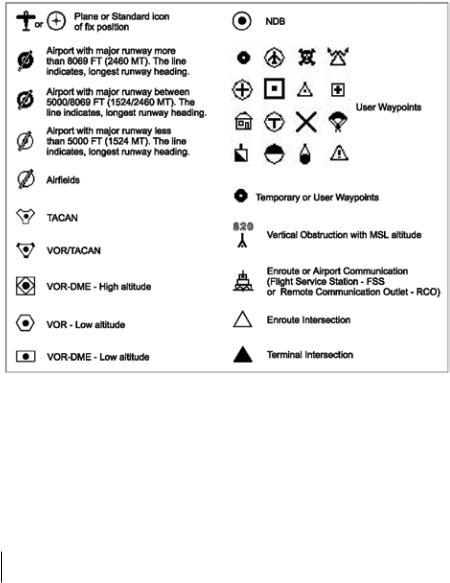
differently based on the mode of operation selected. The Auto Home mode will allow the user to pan away from his present position to view other parts of the map, and return to present position automatically when no buttons are pushed for a pre-determined amount of seconds. Auto Zoom mode will keep your present position, and your destination in the screen at all times. The screen will automatically zoom in as you get closer. To shut off this function, simply select OFF.
The Cursor Mode (OFF Selected) will allow you to move the map to any position to view data or details. To return to your present position, just press ‘ESC’ while in moving map.
The control for these functions is found in the Moving Map Menu, under Auto Position Mode.
1.3.4 Moving Map Icons
The following icons are displayed on the Moving Map to represent Waypoints, navigation aids and airports.
Fig. 1.3.4 - Moving Map Icons
1.3.5 Course Predictor
Indicates the projected position at the set time interval if the current speed and heading are kept. This allows the pilot to correct for wind drift, in real time, right from the moving map. To select course predictor:
> ‘MENU’ 1 sec. + “SYSTEM SETUP” + ‘ENT’ + “FIX SETUP” + ‘ENT’ + “COURSE
PREDICTOR” + ‘ENT’
16

1.3.6 GoTo
GoTo sets a 1-leg course from the present position to any location or selected Waypoint. To activate a GoTo Flight Plan move the cursor to the desired location or Waypoint and press ‘GOTO’. The GoTo menu box will open enabling you to activate the current cursor position or search the Database for a specific object to fly to. To activate the current cursor position, highlight “CURSOR” and press ‘ENT’. To activate a GoTo Flight Plan to a specific Database item, select the category and press ‘ENT’. Select the database item and press ‘GOTO’ again to activate.
To deactivate, press ‘GOTO’ and select “DEACTIVATE”.
1.3.7 Database
The Database function allows the user to access information stored in the data cartridges on
Airports, VOR’s, NDB’s, Intersections and User Waypoints. Searching the Database allows the user to activate GoTo Flight Plans and locate the item on the map. There are two methods of accessing the Database information. The first is through the Database function within the Main Menu and the second is directly from the Moving Map display (see Chapter 3).
17

2 The Basics
This chapter provides general information about the functions of the keys and entering data.
2.1 THE KEYBOARD
The Geopilot II Plus has 7 keys, which access and control features. Some keys perform different tasks based on the operation mode. A quick key guide is displayed at the bottom of many menus for easy reference. Below we indicate the keys in capital letters enclosed between single inverted commas, for example ‘MENU’. When a key, for example ‘MENU’, must be pressed and held down for more than 1 second it is shown as ‘MENU’ 1 sec.
The Near key
‘NEAR’: press and hold to turn the Geopilot II Plus On.
‘NEAR’ 3 sec.: once the GeoPilot has been turned On turns the GeoPilot Off.
‘NEAR’: (immediately release!) Displays a list of the 20 nearest objects, including private airports which contain runways of at least 500 ft. in lenght, relative to fix position or cursor position if no fix is available.
‘NEAR’: 1 sec once the Geopilot II Plus has been turned On displays the Brightness and the
Contrast Menu.
The GoTo key
Activates a Flight Plan to the cursor position (in Moving Map) or to selected object (in other modes).
GOTO 1 sec.: allows the user to quickly filter mapping information on the display. There are three Cycle modes selectable and holding GOTO shifts from one to the other in succession. The default Cycle is the Cycle 1 that normally activates all features to be visible on the display.
To set user preferences for the Cycle Key:
‘MENU’ + “SELECTIVE DISPLAY” + ‘ENTER’
The Cycles appear in the first three columns and are labeled 1, 2 and 3. In order to adjust at which
Cycle features appear, use the Cursor Control key to highlight an item and hit ‘ENTER’ to remove the item from appearing. Hit ENTER again to check the item so that it will appear on the display when that Cycle is activated. Continue to use this procedure to activate features in Cycles 1 - 3 as desired.
The - key
Shows less detail of a larger area by changing the chart scale and zooming out on the map display.
The cursor key
Moves the cursor on the Moving Map, quickly and accurately. Also scrolls to the desired options in menu page(s).
If pressed on the center it works as an ‘ENT’ key, it selects the desired option or confirms selection. Also opens the Cursor/Position Menu.
The + key
Shows more detail of a smaller area by changing the chart scale and zooming in on the map display. If pressed outside the Moving Map it can be used as an ‘ENT’ key
The Esc key
Rejects an action, closes a window or activates Home or Auto Zoom mode.
18
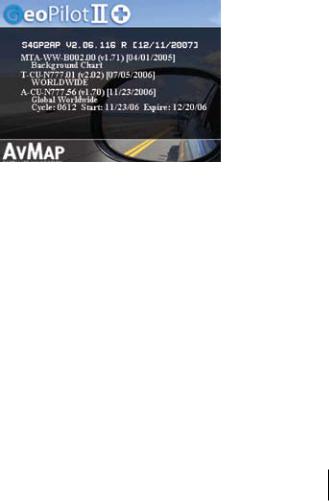
‘Esc’ 3 sec. on the moving map changes the position of the fix icon: one configuration displays the fix icon on the 20% central area of the Moving Map and the other on the exact center of the screen.
The Menu key
‘MENU’: selects the Moving Map Menu.
‘MENU’: press & hold for 1 seconds: opens the Map Presentation Menu
The menu enables the user to select between generic representation mode, three TAWS modes
(auto, low sep and high sep) and two Weather modes (North America only).
2.2 TURNING THE Geopilot II Plus ON/OFF
Before powering On the Geopilot II Plus, check for the correct voltage (10-35 Volt DC).
2.2.1 Turning On
Press and hold ‘NEAR’ for 1 second. The Geopilot II Plus emits one rapid beep sound and a
Title page containing information about the Product name, Software version, library version and cartridges installed is displayed. This data can also be viewed in the “About” page in the “Main
Menu”.
Fig. 2.2.1 - Title page
After a few seconds the Warning page is displayed, reminding you that the Geopilot II Plus is an aid to navigation and should be used with appropriate prudence. The electronic charts are not intended to substitute for the official charts. Press ‘ENT’ to open the Moving Map screen.
2.2.2 Turning Off
‘NEAR’ 3 sec.: a countdown timer appears on the screen, if you release the key before the countdown timer reaches zero, the Geopilot II Plus will remain On.
2.3 CHANGING BRIGHTNESS & CONTRAST
Press and hold 1 sec ‘NEAR’ to adjust the brightness and the contrast of the display and keyboard
(do not press and hold the key or the “power-off ” message will be displayed!).
To increase/decrease the brightness use respectively up/down cursor key. Similarly, to increase/ decrease the contrast use left/right cursor key. In addition the Time and the GPS State are shown.
2.4 SELECTING THE LANGUAGE
It is possible to select the language in which the information is displayed (for screen labels, menus and options, but it does not affect the map information). The default setting is English.
19
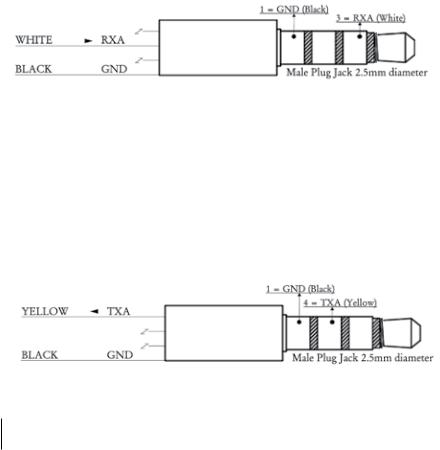
> ‘MENU’ 1 sec. + “SYSTEM SETUP” + ‘ENT’ + “GENERAL SETUP” + ‘ENT’ +
“LANGUAGE” + ‘ENT’
Choose the language you want and press ‘ENT’ again to confirm.
2.5 EXTERNAL CONNECTIONS
2.5.1 Internal/external GPS Source
The Geopilot II Plus has an internal GPS Receiver. Be sure the Fix Source is set to Internal GPS to receive data from this internal receiver.
> ‘MENU’ 1 sec. + “SYSTEM SETUP” + ‘ENTER’ + “FIX SETUP” + ‘ENTER’ + “FIX
SOURCE” + ‘ENTER’
Choose Internal GPS and press ‘ENTER’ to confirm. Otherwise if the Geopilot II Plus is using an external NMEA0183 positioning source, set the Fix Source as External NMEA0183. The recognized Input NMEA0183 messages are the following: GGA, GLL, GSA, GSV, HDG, HDM, HDT, PCMPA,
RMC, VHW, VTG (see Appendix E for more details on NMEA sentences).
> ‘MENU’ 1 sec. + “SYSTEM SETUP” + ‘ENTER’ + “FIX SETUP” + ‘ENTER’ + “FIX SOURCE” + ‘ENTER’
Choose External NMEA0183 and press ‘ENTER’ to confirm.
Fig. 2.5.1 - External Input
2.5.2 NMEA Outputs
The Geopilot II Plus can be connected to external equipment that accepts NMEA0183 data input. Once attached, the output of NMEA formatted position information can be enabled in the following manner:
> ‘MENU’ 1 sec. + “COMMUNICATIONS” + ‘ENTER’ + “NMEA OUTPUT” + ‘ENTER’
The default setting is Off. The Output NMEA0183 messages are the following: APA, APB, BOD, BWC, GGA, GSA, GSV, GLL, HSC, RMA, RMB, RMC, VTG, WCV, XTE (see Appendix F for more details on NMEA sentences) BOD, BWC, GGA, GLL, HSC, RMA, RMB, RMC, VTG, WCV, XTE (see Appendix F for more details on NMEA sentences).
Fig. 2.5.2 - NMEA Connections
20
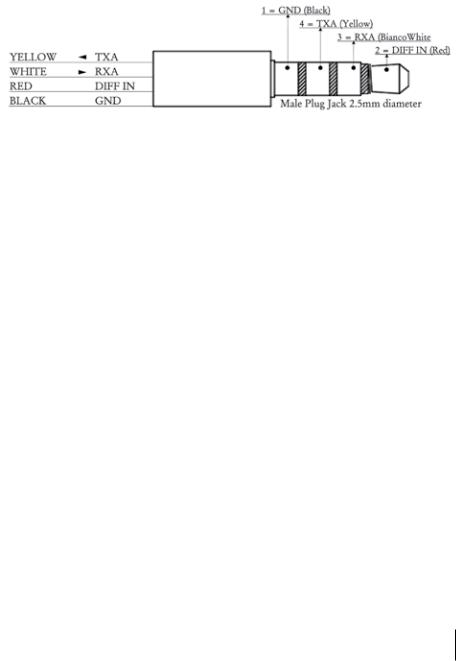
2.5.3 Down Or Up-load Flight Plans & Tracks
The Geopilot II Plus can also send and receive Flight Plans from the AvMap Flight
Planner or another device compatible with it through the serial port (the USB port is for factory use only). This requires an optional data cable that can be purchased from your avionics dealer or AvMap/Navigation for a proper connection to the device (see following figures).
Fig. 2.5.3a - directional Communicatons
2.5.3.1 Download/Upload Waypoints
The Download Waypoint function allows you to send the current Waypoints to the serial port using the NMEA0183 $WPL sentence (see Appendix E):
> ‘MENU’ 1 sec. + “COMMUNICATIONS” + ‘ENTER’ + “WAYPOINTS DOWNLOAD”
+ ‘ENTER’
The Upload Waypoint function allows you to receive Waypoints from the serial port using the NMEA0183 $WPL sentence (see Appendix E):
> ‘MENU’ 1 sec. + “COMMUNICATIONS” + ‘ENTER’ + “WAYPOINTS UPLOAD” + ‘ENTER’
2.5.3.2 Download/Upload Flight Plan
The Download Flight Plan function allows you to send the current Flight Plans to the serial port using the NMEA0183 $WPL and $RTE sentences (see Appendix E):
> ‘MENU’ 1 sec. + “COMMUNICATIONS” + ‘ENTER’ + “FLIGHT PLAN DOWNLOAD” + ‘ENTER’
The Upload Flight Plan function allows you to receive Flight Plans from the serial port using the
NMEA0183 $WPL and $RTE sentences (see Appendix E):
> ‘MENU’ 1 sec. + “COMMUNICATIONS” + ‘ENTER’ + “FLIGHT PLAN UPLOAD” + ‘ENTER’
The received Flight Plan is saved in the current Flight Plan. If the current Flight Plan contains data the user should be asked to confirm the action (overwriting the existing Flight Plan) or choose another Flight Plan.
2.5.3.3 Download Track
The Download Track function allows you to send Track data from the serial port using the CMAP Proprietary NMEA0183 $PCMPT sentence (see Appendix E):
> ‘MENU’ 1 sec. + “COMMUNICATIONS” + ‘ENTER’ + “TRACK DOWNLOAD” +
21

‘ENTER’
2.6 SYSTEM SETUP OPTIONS
You may select how the Geopilot II Plus displays primary information (such as how time is displayed) from the System Setup Menu.
> ‘MENU’ 1 sec. + “SYSTEM SETUP” + ‘ENT’
Refer to Chapter 14 for information about the System Setup Menu.
2.7 DATA ENTRY
Information is keyed into the Geopilot II Plus when editing a Waypoint, entering a Flight Plan, using the calculator and searching the Database. When the field is highlighted:
-Enter or edit data by pressing up/down cursor key to step through the available characters until the desired character is displayed.
-Press right cursor key to move the cursor to the right.
-Use left cursor key to move the cursor to the left.
Some pilot-entered data requires either a +, - or a hemisphere identification:
-Move the cursor over the displayed symbol and press up/down cursor key until the desired symbol appears.
-Press ‘ENT’ to continue to the next line or to return to the previous menu.
22

3 The Moving Maps
The Moving Map is the default state of the software. This mode displays the Moving Map screen and Data Window. The Moving Map displays map detail in Home, Auto Zoom or Cursor mode.
The operation mode will determine the options available within the screen. The Data Window contains the navigation information pertaining to the active flight; these fields can be customized. From the Moving Map screen you can obtain Automatic Info and Full Info for Database objects.
Here you can also open the Cursor/Position Menu for features related to Flight Plans, Waypoints and airspace.
3.1 OPERATING MODES
3.1.1 Cursor Mode
In Cursor mode the screen is controlled by your movement of the cursor. When in Cursor mode, a data field line will appear under the Data Window providing LAT/LON of the cursor position. If a fix has been computed, a distance and bearing will also appear from the position fix to the cursor.
When in Cursor mode it is possible to scroll on the map such that the position fix will not be displayed on the screen. When this occurs, you can quickly display your position by activating Home mode (press ‘ESC’ once). At this time, the system will operate in Home mode (see below
Par. 3.1.2).
If you have a position fix, and would like to continue with the cursor at the last position, press ‘ESC’ again (if the cursor key have not been pressed between these two ‘ESC’ presses, the cursor will revert to the original position). To activate the cursor from the current fix position, simply press the cursor key and the Cursor mode becomes active at the present fix position. The cursor can be used to create and edit Waypoints and Flight Plans; identify airspace, obtain info about objects, project radial lines and measure distance (see Cursor Menu, Par. 3.6).
3.1.2 Auto Home (Screen Amplifier)
The Home mode (also called Screen Amplifier) is used to keep the fix position within the visible map. The map is scrolled and redrawn automatically as your position moves. When this mode is active the cursor is hidden. When in Home mode, there will be no position line displayed at the bottom of the Data Window.
Note
Auto Zoom must be selected to Off in the Moving Map Menu.
A slow flashing airplane icon will indicate your current position. The airplane will be pointing in the direction of movement. Home mode can display the map in North-up, Course-up or Track-up (see
Moving Map Settings, Par. 3.5). To deactivate Home mode press ‘ESC’ activating the cursor at the previous position or press a cursor key to enable the cursor under the current fix position.
3.1.3 Auto Zoom Mode
The Auto Zoom mode is used to keep the fix position and destination (Target) visible on the map. The map is scrolled and zoomed automatically to keep the best view possible. When this mode is active the cursor is hidden. When in Auto Zoom mode, there will be no position line displayed at the bottom of the Data Window.
Note
Auto Zoom must be selected to On in the Moving Map Menu.
23
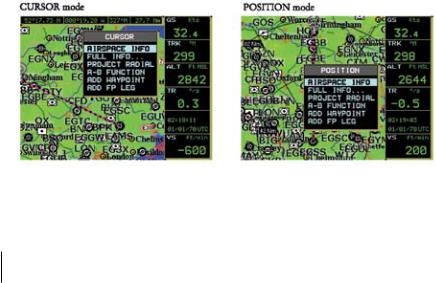
To activate Auto Zoom mode press ‘ESC’ in Moving Map. Auto Zoom requires a position fix and an active destination point. If a destination point is not present it works as Home mode.
To deactivate Auto Zoom mode press ‘ESC’ to enable the cursor at the previous position or press a cursor key to enable the cursor under the current fix position. Instead if you press ‘+’ or ‘-’ enables the cursor under the current fix position and zooms on the map.
3.2 DATA WINDOW
The Moving Map screen provides the option for a Data Window display for a user defined navigation information panel. This window is fixed at the right hand side of the screen. During Cursor mode, an additional line is displayed at the bottom of this box with details on the cursor position. See Par. 3.5.3 and 3.5.4 for details on customizing the data fields display.
The data fields window is updated continuously during flight. For full information regarding navigation and GPS data, you can select the Nav/Location screen from the Main Menu (see Chapter 4).
To view A-B BRG and DST, the “Info: A-B Function” must be selected for display in a Data window field.
3.3 Automatic Info
Automatic Info will provide details on cartographic objects, Waypoints and navaid items when the cursor is placed over them. This is a user setting that can be defined in Moving Map Menu.
The default is Automatic Information to be displayed for aeronautical and terrestrial data.
When the Cursor mode is active, the Automatic Info window appears on the Moving Map screen if there is an object under the cursor position. Depending on the cursor position the window is opened in the top or bottom of the screen.
If additional information is available for the object, the box will indicate with the following message:
“Press and hold MENU to select”. By doing so, you will activate the information box and can then select the item using the cursor key (if more than one item is displayed). With the item highlighted, press ‘ENT’ again and the additional details will be displayed. If the information is an airport, the ‘ENT’ will toggle between the pages of data. Press ‘ESC’ to exit.
3.4 Cursor Or Position Mode
The Moving Map page provides a sub-menu directly related to the cursor or position fix.
To activate from the Moving Map press ‘ENT’. The menu displayed will be Cursor or Position dependent upon the map mode (see map mode above).
Fig. 3.4 - Cursor/Position Menu
3.4.1 Airspace Information
Airspace Info will display information about the airspace within the cursor/position fix. The selected
24

area(s) of airspace queried is highlighted.
>‘ENT’ + “AIRSPACE INFO” + ‘ENT’
Like Automatic Info the window is opened in the top or bottom part of the screen. One window displays all airspace objects. Displayed information is the following: Name of air-space; type of airspace; altitude range; tower frequency for airport traffic areas or main airport frequency for Class B and Class C areas.
Single airspaces under the cursor can be highlighted. Hold MENU 1 sec, then select the airspace to be highlighted and press ENTER. Press ESC in order to return to the Moving Map.
3.4.2 Full Information
Full Info window displays attribute information for the object under the cursor/position.
>‘ENT’ + “FULL INFO” + ‘ENT’
Found objects are presented using a tree structure. Using the cursor key highlight the object desired and press ‘ENT’ for further details.
3.4.3 Project Radial
The project radial feature creates a line at a given bearing and distance from a navaid or user waypoint. If no object is present, an error message stating “Object not found” will appear on the screen. The Geopilot II Plus will store 10 radials. To project a radial, first select the object with the cursor, then:
>‘ENT’ + “PROJECT RADIAL” + ‘ENT’
Using the cursor key enter the Bearing and press ‘ENT’. The Distance box is now active; using the cursor key enter the Distance for the line to extend and press ‘ENT’. To remove a radial, select the object icon or the radial line with the cursor, then:
>‘ENT’ + “PROJECT RADIAL” + ‘ENT’
A Warning message appears asking if you would like to remove the radial. Press ‘ENT’ to confirm or ‘ESC’ to exit. To remove all radials stored in the Geopilot II Plus (see also Par. 14.9):
>‘MENU’ 1 sec. + “SYSTEM SETUP” + ‘ENT’ + “CLEAR ALL RADIALS” + ‘ENT’
3.4.4 A - B Function
The A-B Function allows you to calculate distance and bearing between two specified points (“A” and “B”). The distance and bearing will appear in the A-B data field box at the top of the screen. (This must be selected for display; see Data Window, Par. 3.2). To measure two points:
>Place the cursor at first position “A” + ‘ENT’ + “A-B FUNCTION” + ‘ENT’
>Place the cursor at second position “B” + ‘ENT’ + “A-B FUNCTION” + ‘ENT’
You can also measure distance from the current fix position using the A-B feature. From Home or Auto Zoom mode:
>‘ENT’ + “A-B FUNCTION” + ‘ENT’
This will place “A” at the current fix position, then:
25

>Place the cursor at second position “B” + ‘ENT’ + “A-B FUNCTION” + ‘ENT’
This line will remain on the screen until it is deactivated. To deactivate:
>‘ENT’ + “A-B FUNCTION” + ‘ENT’
3.4.5 Waypoint Handling
Associate Waypoint with User Waypoint Alarm: When editing the waypoint, select the icon for the waypoint. Any Waypoint with this icon will activate a user Waypoint Arrival Alarm if this feature is turned on in the System Setup - Alarm Setup Menu.
The Geopilot II Plus provides storage for 1000 Waypoints. These can be a combination of User
Waypoints or Flight Plan Waypoint storage. User Waypoints can be edited, searched and used as Waypoints within a Flight Plan. User Waypoints can be created from the Moving Map screen or via the Database page (see Database, Chapter 8 for entering Waypoints from the Database).
Add Waypoint
>Place the cursor at position + ‘ENT’ + “ADD WAYPOINT” + ‘ENT’
Edit Waypoint
>Place the cursor over Waypoint + ‘ENT’ + “EDIT WAYPOINT” + ‘ENT’
The Edit Waypoint box will appear. Using the cursor key scroll through the alphanumerics to create an eight character name, adjust the Latitude or Longitude or select an icon. Press ‘ENT’ within each character field to move to the next field. After completing the icon selection, the box will close and the new data is stored. Remove Waypoint (present only if there is a Waypoint under the cursor position):
>Place the cursor over Waypoint + ‘ENT’ + “REMOVE WAYPOINT” + ‘ENT’
A shadow of the icon will remain on the screen until the map is redrawn.
3.4.6 Flight Plan
The Geopilot II Plus provides storage for 15 Flight Plans of 100 legs each. From the Moving Map screen you can edit and create Flight Plans using the cursor. The Flight Plan edited or created will be the one that is currently viewed by the software (see Chapter 6).
Creating a Flight Plan
To create a new Flight Plan from the Moving Map screen, be sure the current viewed Flight Plan (see Chapter 6) is empty. Place the cursor at the desired position on the map, this can be an aero object (APT, VOR, NDB, INT), User Waypoint or a spot on the map.
>‘ENT’ + “INSERT FP LEG” + ‘ENT’
This will create the first Waypoint within your Flight Plan. Continue this way to add the remaining
Waypoints within your Flight Plan.
Note
If several aero objects are found under the cursor, the system will default the selection as follows: Airport, VOR, NDB, INT. If no aero object is found, a temporary Waypoint is placed at the coordinates of the cursor and is named “WPTxxx” (where xxx is a number).
26
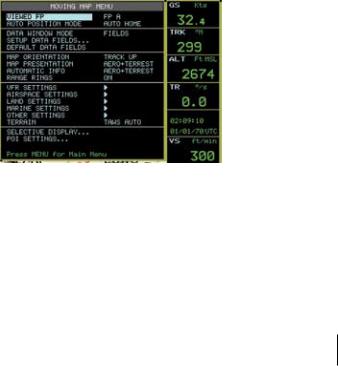
Add Waypoint
To add a Waypoint (leg) to the viewed (current) Flight Plan place the cursor over the position.
>‘ENT’ + “INSERT FP LEG” + ‘ENT’
This will place another leg onto the end of the current viewed Flight Plan.
Remove Waypoint (present only if there is a Waypoint under the cursor position)
>Place the cursor over existing Waypoint + ‘ENT’ + “REMOVE WAYPOINT” + ‘ENT’
If the Waypoint was within the Flight Plan, the revised leg will be drawn on the screen.
Inserting a Waypoint
To edit a flight plan on the moving map, be sure the flight plan is selected as the “Viewed” flight plan. (See Sec. 6.1). To insert a waypoint between two existing waypoints in the viewed flight plan, move the cursor over the leg to be edited:
> ‘ENT’ + “ADD FP LEG” + ‘ENT’.
The new waypoint is now inserted into the flight plan.
3.5 MOVING MAP MENU
The Moving Map Menu provides access to the set up functions of the Moving Map display.
Here you can define the items for display, Map Orientation, Auto Zoom, selective display and other settings to customize the Geopilot II Plus for your navigational needs. From Moving Map press ‘MENU’ to display the Moving Map Menu. From here use the cursor key to select the item desired and press ‘ENT’ to activate. At any time, press ‘ESC’ to back out of the menus and return to the Moving Map.
Fig. 3.5 - Moving Map Menu
3.5.1 Viewed Fp
This item enables you to select the Flight Plan to display on the Moving Map from the list of stored Flight Plans. The Flight Plan that is “Viewed” can then be edited or activated from the Moving Map display.
> ‘MENU’ + “VIEWED FP” + ‘ENT’
The Flight Plan list will display, using the cursor key, highlight the Flight Plan and press ‘ENTER’.
27
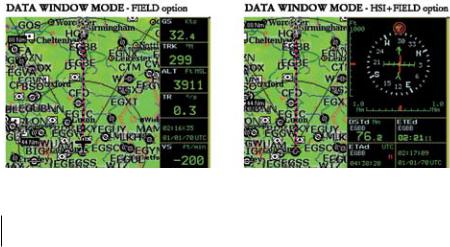
Select an EMPTY Flight Plan if you do not want a Flight Plan to display on the Moving Map, or to create a new Flight Plan from the Moving Map.
3.5.2 Auto Position Mode
To set Auto Zoom or Auto Home mode:
> ‘MENU’ + “AUTO POSITION MODE” + ‘ENTER’
The following options are available:
OFF - The moving map display will remain in ‘CURSOR’ or ‘HOME’ mode as set by the user.
AUTO ZOOM - Used to keep the current position and the destination (Target) visible on the map. The map is scrolled and zoomed automatically to keep the best view possible during all phases of flight. When Auto Zoom is selected, and the cursor is active, the map will reposition the cursor to the center point of the current position fix and the destination waypoint as needed to keep both items visible on the display.
AUTO HOME - The Moving Map page will automatically change to the ‘HOME’ mode when no cursor activity is present for 60 seconds. The default setting is AUTO HOME. Auto Zoom is On the Auto Zoom mode is activated (see Par. 3.1.3).
> ‘MENU’ + “AUTO ZOOM” + “ON”+ ‘ENT’
The Auto Zoom mode is used to keep the fix position and the destination (Target) visible on the map. The map is scrolled and zoomed automatically to keep the best view possible.
3.5.3 Data Window mode
The Data Window is displayed on the top of the Moving Map. This window provides navigation information relating to the Flight Plan and GPS data. This screen can be customized to allow you to select the information based on your flying needs.
>‘MENU’ + “DATA WINDOW MODE” + ‘ENT’
The following options are available for the data window display: OFF
Fields
HSI + Fields - Provides the HSI along with 6 data fields in the top half of the display window. (Settings for the HIS display are selected in the HIS menu).
Fig. 3.5.3 - Data Window options
28
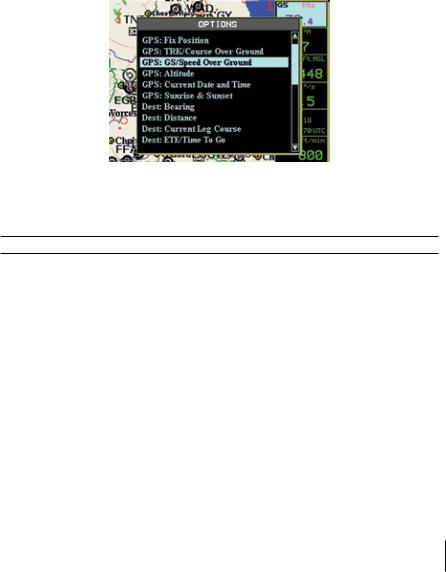
3.5.4 Setup Data Fields
You can select the item to be displayed in each of the fields of the Data Window. The following figure displays the options available. The fields selected for each window mode option (1-line, 2- lines, etc.) are independent; therefore, you can select different fields for each window view.
> ‘MENU’ + “SETUP DATA FIELDS” + ‘ENT’
After pressing ‘ENT’, a box in the Data Window will be highlighted. Using the cursor key, select the box to be edited and press ‘ENT’. The OPTIONS box will appear (see previous figure) allowing you to select the item to display in the highlighted is box. Highlight the desired item from the list and press ‘ENT’ to accept. You can then scroll to another box and proceed as above. Once all boxes are set up, press ‘ESC’ to exit.
Fig. 3.5.4 - Setup Data Fields
Note
Dest. Wpt on the GeoPilot uses 2 fields. Still must be the top field, or the top left when in HSI + Fields mode.
3.5.5 Default Datafields
This will restore data fields settings to default values
> ‘MENU’ + “DEFAULT DATA FIELDS” + ‘ENT’
The message “DONE” will appear to the right confirming the action is complete. The Default Fields will only be applied to the currently selected Data Window Option.
3.5.6 Map Orientation
Map Orientation controls the direction that the Moving Map is pointing during Home and Auto
Zoom modes.
> ‘MENU’ + “MAP ORIENTATION” + ‘ENT’
The options are:
Track-up - will rotate the map automatically to keep your Track pointed toward the top of the display (see Par. 14.2.6; System Setup + Fix Setup + Head Up Response).
Course-up - will rotate the map automatically to keep your active leg pointed toward the top of the display.
29
